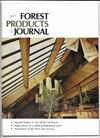Investigating Soil Effects on Outcomes of a Standardized Soil–Block Test
IF 1.2
4区 农林科学
Q3 FORESTRY
引用次数: 1
Abstract
Soil physical and chemical properties play important roles in mass loss during soil–block tests but the relationship between soil properties and the decay caused by brown-rot and white-rot fungi remains unclear. The objective of this study was to investigate the soil effects on the decay resistance of pine (Pinus spp.) and poplar (Liriodendron tulipifera L.) blocks. The properties of soil from nine different sources (six from Idaho, one from Mississippi, one from Wisconsin, and one from Oregon) were characterized for soil texture, sieved bulk density, water-holding capacity, pH, organic matter, and carbon and nitrogen concentrations. The moisture content and mass loss of decayed wood samples after 8 weeks of fungal exposure were measured. At the end of the study, block moisture ranged from 30 to 200 percent and mass loss ranged from 20 to 60 percent. Despite using a range of soils, there were no direct correlations between soil properties and wood-block moisture content or mass loss. Moreover, among all the soil properties examined, no significant effect of a single soil property on wood-block moisture content and mass loss was measured. Instead, the combined effects of soil physical and chemical properties may interact to govern the decay of wood blocks in the laboratory soil–block test.研究土壤对标准化土块试验结果的影响
土壤物理和化学性质在土壤块体试验中的质量损失中起着重要作用,但土壤性质与褐腐真菌和白腐真菌引起的腐烂之间的关系尚不清楚。本研究的目的是研究土壤对松(Pinus spp.)和杨(Liriodendron tulipifera L.)块体耐腐性的影响。对来自9个不同来源(6个来自爱达荷州,1个来自密西西比州,一个来自威斯康星州,1个位于俄勒冈州)的土壤性质进行了表征,包括土壤质地、筛分堆积密度、持水能力、pH值、有机质以及碳和氮浓度。测量腐朽木材样品在真菌暴露8周后的水分含量和质量损失。研究结束时,块体水分在30%至200%之间,质量损失在20%至60%之间。尽管使用了一系列土壤,但土壤性质与木块含水量或质量损失之间没有直接相关性。此外,在所有检查的土壤性质中,没有测量到单一土壤性质对木块含水量和质量损失的显著影响。相反,在实验室土块试验中,土壤物理和化学性质的综合影响可能会相互作用,控制木块的腐烂。
本文章由计算机程序翻译,如有差异,请以英文原文为准。
求助全文
约1分钟内获得全文
求助全文
来源期刊

Forest Products Journal
工程技术-材料科学:纸与木材
CiteScore
2.10
自引率
11.10%
发文量
30
审稿时长
6-12 weeks
期刊介绍:
Forest Products Journal (FPJ) is the source of information for industry leaders, researchers, teachers, students, and everyone interested in today''s forest products industry.
The Forest Products Journal is well respected for publishing high-quality peer-reviewed technical research findings at the applied or practical level that reflect the current state of wood science and technology. Articles suitable as Technical Notes are brief notes (generally 1,200 words or less) that describe new or improved equipment or techniques; report on findings produced as by-products of major studies; or outline progress to date on long-term projects.
 求助内容:
求助内容: 应助结果提醒方式:
应助结果提醒方式:


